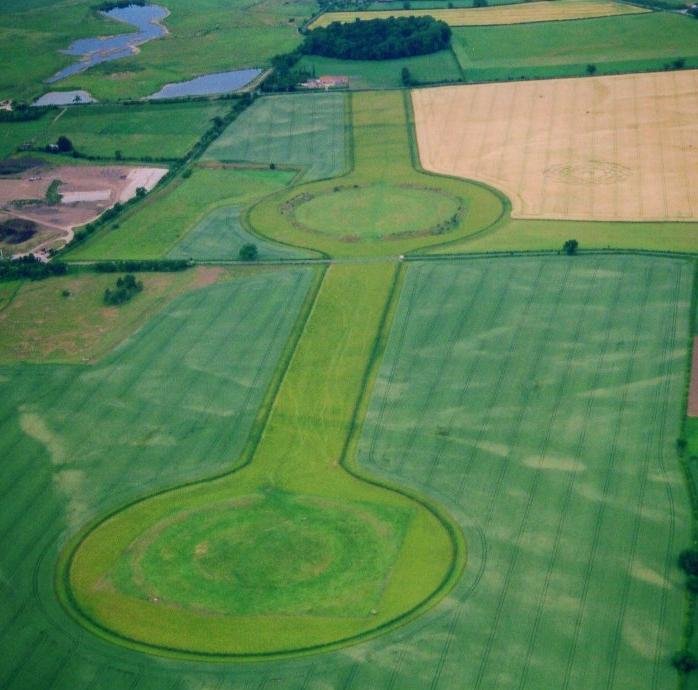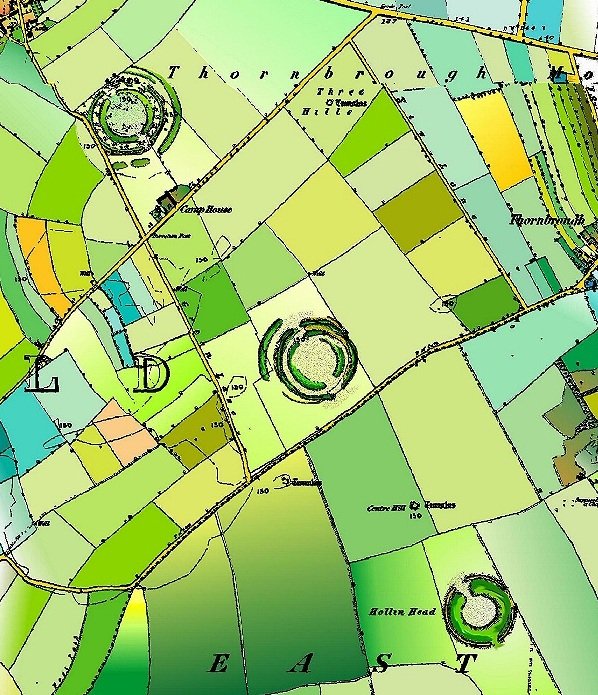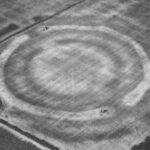Contents
The Geological Landscape of Thornborough: Shaping the Land Before Humans
The Thornborough Henges are located within a distinctive and complex landscape that has been shaped over millennia by a combination of glacial forces, river systems, and post-glacial climatic changes. The landscape of Thornborough is defined by its geological foundations and the dynamic processes that transformed the area long before human presence.
Glacial Impact: Shaping the Valley
The region surrounding Thornborough was fundamentally altered by the Pleistocene glaciations. Around 12,000 years ago, the last ice sheets retreated, leaving behind a landscape that bears the marks of glacial processes. The Pennine Hills to the west and the Vale of Mowbray to the east are composed of older Carboniferous and Permian rocks, but the Thornborough area itself lies within a flat, glacially-formed valley. This area was shaped by glacial erosion and deposition, leaving behind glacial till, sand, gravel, and silt.
Glacial Scouring: As glaciers advanced and retreated, they scoured the valley floors, deepening and flattening the terrain. This erosional process carved out valleys, such as those seen in the Ure and Swale river systems. These valleys created relatively level ground that would later become ideal for settlement—first for wildlife, then for human activity.
Depositional Features: As the glaciers melted, they left behind a range of depositional features, including moraines (ridges of debris), kames (mound-like features), and eskers (long, winding ridges). These features are visible in the surrounding areas and helped to form the underlying structure of the landscape, including the raised terraces along the rivers. These terraces represent different stages of riverbed evolution and give insight into past climatic conditions.
River Systems and Sedimentation
The Swale and Ure rivers played a key role in shaping the landscape around Thornborough. As the glaciers retreated, meltwater from the ice sheets created powerful rivers that reworked the sediments, forming braided channels and floodplains.
River Evolution: Over time, the rivers altered their course, creating terraces and alluvial deposits (sediments deposited by flowing water). The Swale and Ure rivers shifted course, leaving behind sedimentary layers that provided fertile ground for vegetation, and later, settlement. These changing river dynamics contributed to the morphology of the Thornborough valley, making it a significant feature of the region.
Alluvial Deposits: The rivers, particularly the Swale, deposited rich layers of silt, sand, and gravel along their banks. This made the land fertile and ideal for later agricultural activities, but long before humans arrived, these deposits were the foundation for thriving ecosystems of plants and animals. The presence of these alluvial deposits is also key to understanding how the landscape transformed and why it was so significant in the pre-human environment.
Post-Ice Age Environmental Changes
After the last ice sheets melted, the climate of the Thornborough area shifted, bringing about an era of dramatic environmental change.
Holocene Climate: Following the cold period of the Ice Age, the climate warmed significantly, leading to the Holocene epoch, roughly 10,000 years ago. The region saw a gradual transition from a cold tundra environment to a more temperate forest landscape. As the climate warmed, new plant species began to spread, including pine, oak, and hazel.
Vegetation Expansion: The warming climate encouraged the growth of forests and woodlands, and the Thornborough area would have been covered by dense woodland, with species like pine and hazel thriving in the river valley. These forests were rich in resources, providing shelter for wildlife and enabling the growth of plant species that would shape the future ecosystems.
Wetlands and Floodplains: The river valleys remained fertile and dynamic. The Swale and Ure rivers continued to meander, sometimes flooding their banks and creating wetlands. These areas were ecologically rich, with reed beds, marshes, and shallow waters that supported a wide range of plant and animal life.
The Creation of Landforms for Future Human Interaction
By the end of the last Ice Age, the Thornborough area had transformed into a fertile landscape, marked by floodplains, moraines, and river terraces. The fertile soil and proximity to water would have made it an ideal location for early human communities.
The moraine ridges and river terraces provided natural elevated views, and their positioning would have made them ideal for prehistoric monumental construction. The combination of flat valleys for settlement, fertile land for agriculture, and elevated ridges for ceremonial or ritual purposes might explain why the Thornborough Henges were placed where they were.
Conclusion: Thornborough’s Evolving Landscape
The landscape surrounding the Thornborough Henges is the product of millions of years of geological processes, from the Pleistocene glaciers that shaped the valleys to the post-glacial river systems that formed the fertile grounds for future settlement. This landscape, shaped by glaciation, erosion, and sedimentation, provided the foundation for the region’s future ecological and human developments.
By understanding the landforms and geological features that predate human activity, we can gain a deeper appreciation for how the Thornborough Henges were integrated into the landscape. The surrounding moraine ridges, river terraces, and floodplains provided a natural setting that may have influenced the siting of monumental structures, making Thornborough an area of both ecological and cultural significance.













